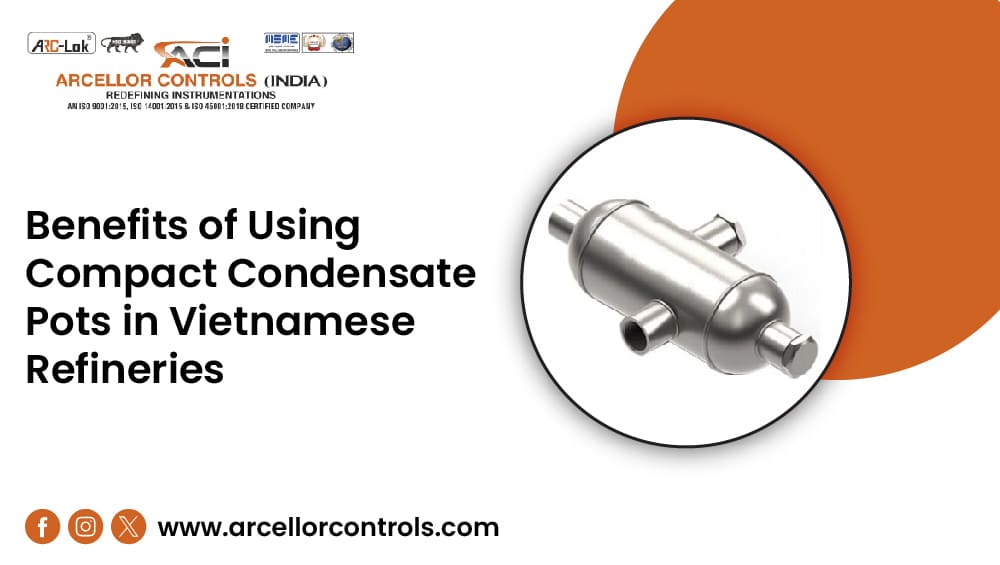Call us 8:00am - 8:00pm
079-2273 3345 / 6353949804
Monday to Friday
8:00am - 8:00pm

Benefits of Using Compact Condensate Pots in Vietnamese Refineries
Effective steam and high-temperature fluid management is necessary in the refinery systems. The compact condensate pot in Vietnam refineries is an invaluable component because it assists in the management of steam and extreme temperatures. In this article, we will discuss the mini steam condensate vessel, and will also help you understand the small condensate pot benefits in Vietnamese refineries.How is a compact condensate pot different than a regular condensate pot?
The compact condensate pot installation is perfect for the tight layouts with limited space, instrument skids, and modular systems. These mini steam condensate vessels are the best in refinery plants that have limited space because they are a variant of the condensate pot with a smaller size but have the same protective function; the capacity of such a device is comparatively lower.How does a compact condensate pot work in a refinery?
-
Condensate Collection
-
Stabilization of Liquid Columns
-
Thermal Protection
-
Venting and Drainage
What is the Role of Compact Condensate Pots in Refinery Operations?
1. Systems for steam tracing
Steam tracing is a process that is a part of many refinery operations. Its main aim is to maintain the temperature of the process lines carrying sulfur, waxes, heavy hydrocarbons, or other viscous fluids. These fluids must maintain a certain temperature to avoid solidification or obstructions. A mini steam condensate vessel offers a space-efficient solution to them without compromising on functionality.2. Compact units mounted on skids
Modular skid-mounted units are used in many refineries where chemical dosing systems are necessary. These skids are compact and preassembled. Conventional condensate pots are not viable due to limited arrangement space for skids. These units are easier to install and allow for modularity and preserve the instrumental integrity without affecting other parts.3. Systems for Boiler Feeding
Boilers produce high-pressure steam in a variety of refinery operations. High-temperature pipes, feedwater tanks, economizers, and control valves are all parts of the boiler feed system. Engineers install this equipment in small enclosures and boiler feed regions frequently where there is a dense pipe network.4. Limited Spacing High-Pressure Loops
The precision DP measurement condensate pot is handy in crude distillation, hydrocracking, and reforming units. The refineries function at extremely high temperatures and pressure and are highly sensitive to pressure changes. These loops require accurate monitoring, which is possible because of this device. Moreover, the installation space in these locations is very little because it is taken over by heat exchangers, reactors, and pipe insulation. Therefore, in such situations, it is easier to maintain a compact condensate pot.What are the Key Gains in integrating Compact Condensate Pot in Vietnam’s Refinery Plants?
1. Space-saving condensate pot
The installation of compact condensate pots is important because they have a precise design with decreased weight and dimensions. This feature makes them perfect for small piping networks, particularly in settings like refinery skids and steam tracking loops. They offer the same capabilities as a precision DP measurement condensate pot, but they take up less space, and compact condensate pot installation is easy both vertically and horizontally. The space around high-pressure systems in refineries like Dung Quat or Nghi Son is very small. There is not much space for large instrumentation piping systems because of their enclosed or dense system. In such situations, a space-saving condensate pot fits perfectly without the need for structural support or line routing.2. Quicker to Set up
It is easy to install the mini steam condensate vessel quickly and uniformly because it is preconfigured with integral threading or socket-weld connections. Certain models of space-saving condensate pots may also include pre-tapped apertures for drain and vent valves and universal mounting brackets. The mini steam condensate vessel is smaller in size, so they are easier to move, lift, and align with the piping systems. This aspect accelerates the installation procedure. Refineries have a tight shutdown and turnaround timetable. Therefore, saving on installation time can help the refinery to start work faster and increase production. The labor and alignment time is also less in compact condensate pot installation.3. Preserves the accuracy of measurement
A steady fluid column is very important in the loops so that there is perfect monitoring of different pressures. A small condensate pot ensures that the condensation is confined beneath the pressure tap. Moreover, the saturated steam or dry gas enters the impulse line effectively. The liquid head also remains constant on the transmitter’s high and low sides. Even though the mini steam condensate vessel has a small body, the internal volume is enough to permit the separation of the liquid and vapor phases. This reduces signal fluctuations and preserves the integrity of the differential pressure. Even slight changes in pressure and Vietnam refinery flow accuracy and boiler drum levels can lead to serious flow errors, and the compact pot takes care of it. They also guarantee instrument accuracy under a range of load, ambient, and process conditions.Conclusion
The mini steam condensate vessel offers a very practical and efficient solution in the harsh conditions of Vietnamese refineries and ensures Vietnam refinery fluid flow accuracy. The small condensate pot benefits the limited space in the piping systems, and so they serve the same vital purpose as their larger counterparts. The compact condensate pot installation protects the instruments well, stabilizes the pressure readings, and controls condensate. Moreover, the space-saving condensate pot design is tailored in such a way that it can handle extremely high temperature-related issues of high-pressure units, modular skids, and boiler loops. Arcellor Controls provides compact condensate pots for Vietnamese refineries and mini steam condensate vessels that are thoroughly inspected to ensure that they meet the efficiency requirements for various industrial operations. Get in touch with us to know moreGet in Touch
You will find yourself working in a true partnership that results in an incredible experience, and an end product that is the best.





Post A Comment